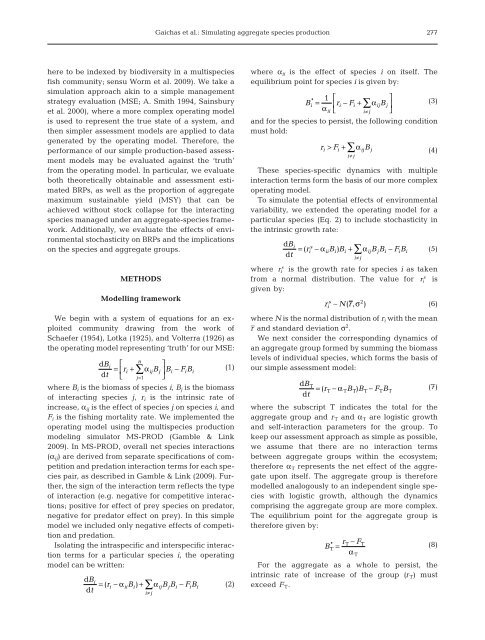Complete Theme Section in pdf format - Inter Research
Complete Theme Section in pdf format - Inter Research
Complete Theme Section in pdf format - Inter Research
Create successful ePaper yourself
Turn your PDF publications into a flip-book with our unique Google optimized e-Paper software.
Gaichas et al.: Simulat<strong>in</strong>g aggregate species production<br />
277<br />
here to be <strong>in</strong>dexed by biodiversity <strong>in</strong> a multispecies<br />
fish community; sensu Worm et al. 2009). We take a<br />
simulation approach ak<strong>in</strong> to a simple management<br />
strategy evaluation (MSE; A. Smith 1994, Sa<strong>in</strong>sbury<br />
et al. 2000), where a more complex operat<strong>in</strong>g model<br />
is used to represent the true state of a system, and<br />
then simpler assessment models are applied to data<br />
generated by the operat<strong>in</strong>g model. Therefore, the<br />
performance of our simple production-based assessment<br />
models may be evaluated aga<strong>in</strong>st the ‘truth’<br />
from the operat<strong>in</strong>g model. In particular, we evaluate<br />
both theoretically obta<strong>in</strong>able and assessment estimated<br />
BRPs, as well as the proportion of aggregate<br />
maximum susta<strong>in</strong>able yield (MSY) that can be<br />
achieved without stock collapse for the <strong>in</strong>teract<strong>in</strong>g<br />
species managed under an aggregate-species framework.<br />
Additionally, we evaluate the effects of environmental<br />
stochasticity on BRPs and the implications<br />
on the species and aggregate groups.<br />
METHODS<br />
Modell<strong>in</strong>g framework<br />
We beg<strong>in</strong> with a system of equations for an exploited<br />
community draw<strong>in</strong>g from the work of<br />
Schaefer (1954), Lotka (1925), and Volterra (1926) as<br />
the operat<strong>in</strong>g model represent<strong>in</strong>g ‘truth’ for our MSE:<br />
n<br />
dBi<br />
⎡<br />
⎤<br />
= (1)<br />
dt<br />
⎢ri + ∑αijBj⎥Bi − FB i i<br />
⎣ j=<br />
1 ⎦<br />
where B i is the biomass of species i, B j is the biomass<br />
of <strong>in</strong>teract<strong>in</strong>g species j, r i is the <strong>in</strong>tr<strong>in</strong>sic rate of<br />
<strong>in</strong>crease, α ij is the effect of species j on species i, and<br />
F i is the fish<strong>in</strong>g mortality rate. We implemented the<br />
operat<strong>in</strong>g model us<strong>in</strong>g the multispecies production<br />
model<strong>in</strong>g simulator MS-PROD (Gamble & L<strong>in</strong>k<br />
2009). In MS-PROD, overall net species <strong>in</strong>teractions<br />
(α ij ) are derived from separate specifications of competition<br />
and predation <strong>in</strong>teraction terms for each species<br />
pair, as described <strong>in</strong> Gamble & L<strong>in</strong>k (2009). Further,<br />
the sign of the <strong>in</strong>teraction term reflects the type<br />
of <strong>in</strong>teraction (e.g. negative for competitive <strong>in</strong>teractions;<br />
positive for effect of prey species on predator,<br />
negative for predator effect on prey). In this simple<br />
model we <strong>in</strong>cluded only negative effects of competition<br />
and predation.<br />
Isolat<strong>in</strong>g the <strong>in</strong>traspecific and <strong>in</strong>terspecific <strong>in</strong>teraction<br />
terms for a particular species i, the operat<strong>in</strong>g<br />
model can be written:<br />
dBi<br />
= ( ri − αiiBi)<br />
+ ∑αijBjBi<br />
−FB<br />
i i<br />
dt<br />
i≠<br />
j<br />
(2)<br />
where α ii is the effect of species i on itself. The<br />
equilibrium po<strong>in</strong>t for species i is given by:<br />
B * 1 ⎡<br />
⎤ (3)<br />
i = ⎢ri − Fi + ∑αijBj<br />
α<br />
⎥<br />
ii ⎣<br />
i≠<br />
j ⎦<br />
and for the species to persist, the follow<strong>in</strong>g condition<br />
must hold:<br />
r > F + ∑α B<br />
i i ij j<br />
i≠<br />
j<br />
These species-specific dynamics with multiple<br />
<strong>in</strong>teraction terms form the basis of our more complex<br />
operat<strong>in</strong>g model.<br />
To simulate the potential effects of environmental<br />
variability, we extended the operat<strong>in</strong>g model for a<br />
particular species (Eq. 2) to <strong>in</strong>clude stochasticity <strong>in</strong><br />
the <strong>in</strong>tr<strong>in</strong>sic growth rate:<br />
dBi<br />
= ( ri s − αiiBi)<br />
Bi + ∑αijBjBi −FB<br />
i i (5)<br />
dt<br />
i≠<br />
j<br />
s<br />
where r i is the growth rate for species i as taken<br />
s<br />
from a normal distribution. The value for r i is<br />
given by:<br />
ri s ∼ N( r, σ 2 )<br />
(6)<br />
where N is the normal distribution of r i with the mean<br />
r – and standard deviation σ 2 .<br />
We next consider the correspond<strong>in</strong>g dynamics of<br />
an aggregate group formed by summ<strong>in</strong>g the biomass<br />
levels of <strong>in</strong>dividual species, which forms the basis of<br />
our simple assessment model:<br />
dBT<br />
= ( r (7)<br />
T−α<br />
TBT)<br />
BT−FTBT<br />
dt<br />
where the subscript T <strong>in</strong>dicates the total for the<br />
aggregate group and r T and α Τ are logistic growth<br />
and self-<strong>in</strong>teraction parameters for the group. To<br />
keep our assessment approach as simple as possible,<br />
we assume that there are no <strong>in</strong>teraction terms<br />
between aggregate groups with<strong>in</strong> the ecosystem;<br />
therefore α Τ represents the net effect of the aggregate<br />
upon itself. The aggregate group is therefore<br />
modelled analogously to an <strong>in</strong>dependent s<strong>in</strong>gle species<br />
with logistic growth, although the dynamics<br />
compris<strong>in</strong>g the aggregate group are more complex.<br />
The equilibrium po<strong>in</strong>t for the aggregate group is<br />
therefore given by:<br />
B * rT−<br />
FT<br />
(8)<br />
T =<br />
α T<br />
For the aggregate as a whole to persist, the<br />
<strong>in</strong>tr<strong>in</strong>sic rate of <strong>in</strong>crease of the group (r T ) must<br />
exceed F T .<br />
(4)
















